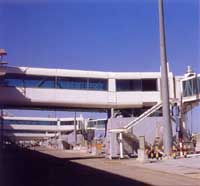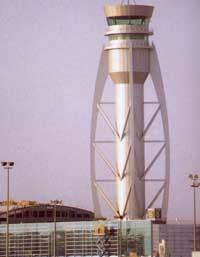A whole new ball game
The new millennium will see one of Dubai's most exciting developments come
to fruition, and Al Shindagah enjoys a guided tour of the futuristic project
to be used by millions of travellers to the emirate every year
 If the futuristic movies of the 1950's were to believed, we would all be walking around in silver suits in the Year 2000, driving to work in floating vehicles and keeping robotic pets. How wrong those movie directors were!
If the futuristic movies of the 1950's were to believed, we would all be walking around in silver suits in the Year 2000, driving to work in floating vehicles and keeping robotic pets. How wrong those movie directors were!
In reality, things have moved on at an amazing rate and technology has advanced beyond the 20th century boffins' wildest dreams, but let's face it, we are still no different to the generations before us; we still eat, breath and work just like at any other time in the recent history of the human time-line and it is unlikely to change much in the near future either!
But one thing those science fiction movies almost got right is the architecture of the 21st century and no where else in the world is this captured more so than Dubai.
The buildings being thrown up by the month consist of stunning designs, which is one of the prime reasons as to why Dubai is considered as one of the world's most modern cities. With the Burj Al Arab complex on Jumeirah Beach now up-and-running as the world's tallest and most luxurious hotel, and the Emirates Towers complex on Sheikh Zayed Road set to open soon, visitors and residents of Dubai have never had it so good. But the new airport development is set to elevate the city to a new level once again.
The US$540 million project is set to open on March 1, when Dubai's latest edition to the world of modern architecture will be unveiled.
It is hard to find words that describe this development but flabbergasting would be close. Imagine the concept of the iMac stretched into the shape of an aircraft body with the interior resembling Dr Who's Tardis and you may be close to what will greet up to 12 million visitors to Dubai in its first year.
At 800 metres from nose to tail, the new Dubai concourse will ensure the airport will be considered as one of the world's best. A five star hotel, 10,000 sqms of shopping (almost the complete size of the new Terminal 2 building), numerous food outlets and even an Irish pub will be housed in the new complex along with a host of other new innovations.
It is all coming together under a joint venture between a local company, Al Habtoor Engineering, and Murray & Roberts, a South African firm which has already made its mark in the UAE.
"It is an incredible development," said Duncan Meredith, the Project Director who has worked with Murray & Roberts for 25 years. "Seeing is believing because you can not get a proper idea of what it is all about just by looking at its exterior. This is the sort of development that will help take Dubai into the 21st Century as one of the world's most modern cities."
With five levels and a new aircraft control tower, the concourse will be large enough to handle 55 aircraft at a time. The short-term goal is to eventually raise Dubai International Airport's capacity to 20 million passengers a year. Located 300 metres north of the existing terminal, the concourse measures 80 metres wide and up to 28 metres high. Its vast structure will be covered in blue-green glazed panels reflecting the sky to make a lasting impression to the millions who will use it.
A 300-metre moving walkway-equipped passenger tunnel links the new concourse with the existing terminal. A boarding level contains spacious holding lounges, 28 gates, 42 air bridges and additional access to 27 remote parking positions. The five-star hotel consists of 100 superbly appointed rooms, high-class restaurants not to mention the state-of-the-art leisure and business facilities that would compliment any top notch city centre hotel. Throw in an entertainment centre, automated baggage system, and superb decor throughout its interior and the makings of a world-class airport are apparent.
 "I think it will rival any of the best airports in the world," added Meredith. "The airport is scheduled to open on March 1 and we are working flat out to meet that deadline."
"I think it will rival any of the best airports in the world," added Meredith. "The airport is scheduled to open on March 1 and we are working flat out to meet that deadline."
The current status of the development speaks volumes for the construction partnership forged by Al Habtoor and the Murray & Roberts company. The joint venture only got the green light to work on the job in January 1998, and the first steel was only put in place on June 17, 1998. In simple terms, the job from start to finish will only take around 21 months to complete.
"It has been built during a period of over trading in the UAE," explained Meredith. "There has been a big rush to get projects finished in time for the millennium, and it has put a lot of pressure on the work force here. There is a limit on the number of labourers that can be imported here now so it has been a challenge in that respect.
"To get an idea of the size of the project, you only have to remember that the Emirates Tower is 340 metres high. The new concourse is twice the length of that with change."
This is not the first time that Al Habtoor has forged a successful partnership with Murray & Roberts. The two made a successful joint bid to work on the Burj Al Arab contract and Meredith was heavily involved in that project too.
"I remember the day well that we put in the bid," he said. "It was May 24, 1995, because that was the first day of the Rugby World Cup in South Africa."
The rest, as they say, is history and the two companies have forged one of the most powerful engineering enterprises in the Middle East since, with plenty of other projects expected to bear the Al Habtoor and Murray & Roberts mark.
Up to 6,000 workers have been involved with the development of the new concourse, one of Dubai's biggest ever construction challenges, and a walk through the building site reveals all.
"Standing here gives you a better idea of it's length," said Meredith as we stand on a bridge at the half-way point of the building. Through the scaffolding and the dust thrown up by the grinders you can make out the ends of the building. Indeed it is a huge complex.
The arrival and departure routes have been carefully laid out through the concourse, and a system has been devised to enable transit passengers to take advantage of the wealth of duty free shopping.
"Everyone will pass through this area. It seems strange to think that around one million people every month will walk through here soon," said Meredith close to the site of the duty free shopping.
The hotel is located close to the building's halfway mark and its amenities are impressive. The meeting and conference facilities will be equipped with the sort of gadgetry expected by the modern-day traveller, while there is a choice of rooms ranging from the standard, consisting of a studio room and a bathroom, to the presidential suite which takes up four units. There is also the leisure facilities consisting of a health spa, swimming pool and gymnasium... at times it is hard to believe we are still in an international airport!
 The range of eating facilities would be the envy of any mid-sized shopping mall with leading fast-food outlets and coffee shops to cater for a majority of travellers, a luxury restaurant will satisfy the more discerning traveller.
The range of eating facilities would be the envy of any mid-sized shopping mall with leading fast-food outlets and coffee shops to cater for a majority of travellers, a luxury restaurant will satisfy the more discerning traveller.
First class and business lounges will also enjoy a new level of hospitality in Dubai with the major airlines opening their own facilities within the concourse.
Away from public viewing, there is the mass of administrative offices, a medical centre, staff kitchens and police facilities which will be equipped with holding cells.
All in all, an impressive new construction, and one which will help Dubai's long-term goal of attracting 45 million passengers through its international airport every year. To help accommodate so many travellers, Dubai International Airport will construct another concourse running on from the one currently under construction. As if this development is not staggering enough, the next one is anticipated to be 100 metres longer!
A look at Al Habtoor...
The Dubai International Airport concourse is the latest in a long line of triumphs and success stories for the Al Habtoor Group which is one of Dubai's pioneering companies.
Al Habtoor Engineering Enterprises Company, LLC was the founding organisation of Al Habtoor. It was established in 1970 and its subsequent years of steady success contributed towards the entire group's expansion and diversification.
The Company's experienced international management team are capable of undertaking construction projects ranging form multi-complex hotels and hospitals and residential apartment towers and villas, and special projects such as military bases and camps.
 In 1994, AL Habtoor Engineering completed the prestigious Holiday Centre Complex on Dubai's Sheikh Zayed Highway which includes an office block, shopping mall, residential apartment block and a large luxury hotel. In 1995, the 29-storey Dubai Creek Tower was completed, a high-rise residential and office complex that is one of the tallest buildings in the Southern Gulf. More recent projects include both the Main Tower Hotel, rising to a staggering 321 metres and the 600 bedroom Resort Hotel on the prestigious Chicago Beach Resort Development; the 213 suites and bedrooms Metropolitan Palace Hotel and a development of 204 hotel suites and a commercial centre in Jumeirah, as well as residential towers, a palace and military works in Abu Dhabi.
In 1994, AL Habtoor Engineering completed the prestigious Holiday Centre Complex on Dubai's Sheikh Zayed Highway which includes an office block, shopping mall, residential apartment block and a large luxury hotel. In 1995, the 29-storey Dubai Creek Tower was completed, a high-rise residential and office complex that is one of the tallest buildings in the Southern Gulf. More recent projects include both the Main Tower Hotel, rising to a staggering 321 metres and the 600 bedroom Resort Hotel on the prestigious Chicago Beach Resort Development; the 213 suites and bedrooms Metropolitan Palace Hotel and a development of 204 hotel suites and a commercial centre in Jumeirah, as well as residential towers, a palace and military works in Abu Dhabi.
The company has additionally diversified into steel-frame housing, and has successfully completed over 100 villas, using this rapid construction technique that has been well received by tenants. A recent major success has been the astounding and futuristic Officer's Club in Abu Dhabi, where an estimated 60,000 square metre of quality woods and marbles have been laid under the largest shell span of its type anywhere in the world. In concept and size, the root structure of the club could well be a candidate for the Guiness Book of Records.
Al Habtoor Engineering is also a specialist in hospital construction, having built the main extension to Rashid Hospital, plus Al Wasl Hospital and the New Dubai Hospital, Dubai's first modern medical facilities. Additional major hospitals in the Emirates have been constructed by the company.